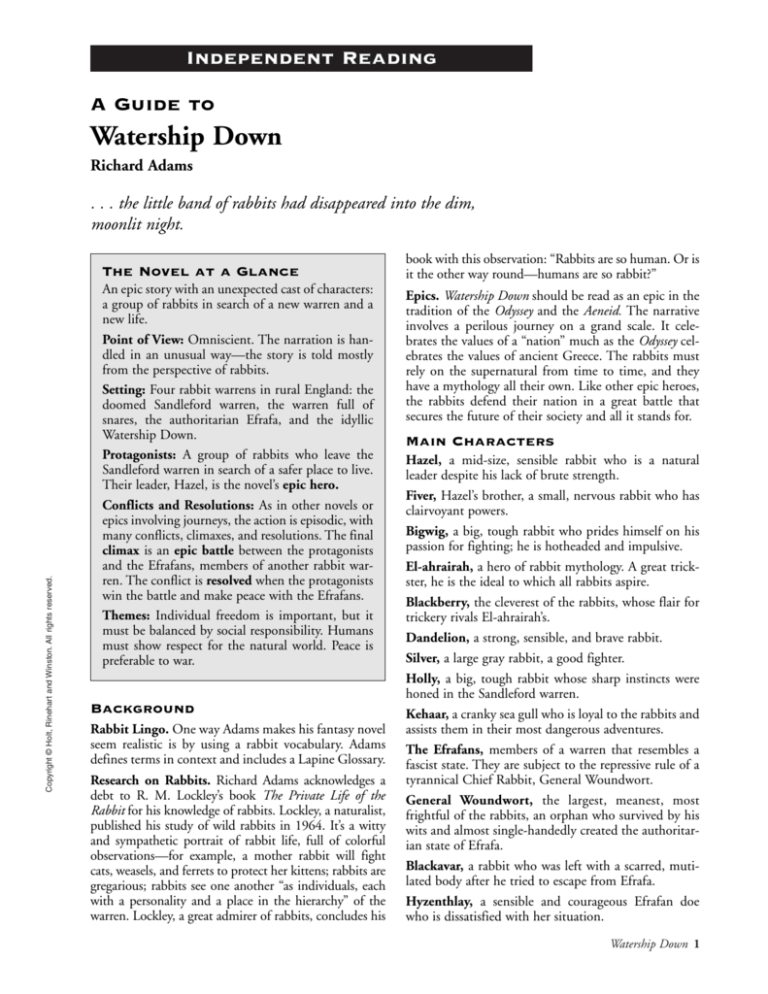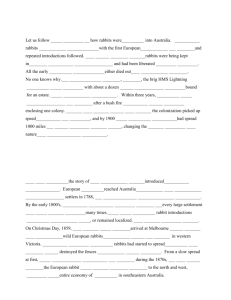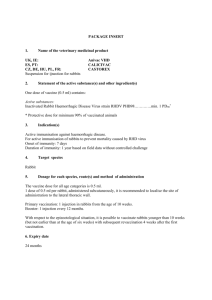
Independent Reading
A Guide to
Watership Down
Richard Adams
. . . the little band of rabbits had disappeared into the dim,
moonlit night.
Copyright © Holt, Rinehart and Winston. All rights reserved.
The Novel at a Glance
An epic story with an unexpected cast of characters:
a group of rabbits in search of a new warren and a
new life.
Point of View: Omniscient. The narration is handled in an unusual way—the story is told mostly
from the perspective of rabbits.
Setting: Four rabbit warrens in rural England: the
doomed Sandleford warren, the warren full of
snares, the authoritarian Efrafa, and the idyllic
Watership Down.
Protagonists: A group of rabbits who leave the
Sandleford warren in search of a safer place to live.
Their leader, Hazel, is the novel’s epic hero.
Conflicts and Resolutions: As in other novels or
epics involving journeys, the action is episodic, with
many conflicts, climaxes, and resolutions. The final
climax is an epic battle between the protagonists
and the Efrafans, members of another rabbit warren. The conflict is resolved when the protagonists
win the battle and make peace with the Efrafans.
Themes: Individual freedom is important, but it
must be balanced by social responsibility. Humans
must show respect for the natural world. Peace is
preferable to war.
Background
Rabbit Lingo. One way Adams makes his fantasy novel
seem realistic is by using a rabbit vocabulary. Adams
defines terms in context and includes a Lapine Glossary.
Research on Rabbits. Richard Adams acknowledges a
debt to R. M. Lockley’s book The Private Life of the
Rabbit for his knowledge of rabbits. Lockley, a naturalist,
published his study of wild rabbits in 1964. It’s a witty
and sympathetic portrait of rabbit life, full of colorful
observations—for example, a mother rabbit will fight
cats, weasels, and ferrets to protect her kittens; rabbits are
gregarious; rabbits see one another “as individuals, each
with a personality and a place in the hierarchy” of the
warren. Lockley, a great admirer of rabbits, concludes his
book with this observation: “Rabbits are so human. Or is
it the other way round—humans are so rabbit?”
Epics. Watership Down should be read as an epic in the
tradition of the Odyssey and the Aeneid. The narrative
involves a perilous journey on a grand scale. It celebrates the values of a “nation” much as the Odyssey celebrates the values of ancient Greece. The rabbits must
rely on the supernatural from time to time, and they
have a mythology all their own. Like other epic heroes,
the rabbits defend their nation in a great battle that
secures the future of their society and all it stands for.
Main Characters
Hazel, a mid-size, sensible rabbit who is a natural
leader despite his lack of brute strength.
Fiver, Hazel’s brother, a small, nervous rabbit who has
clairvoyant powers.
Bigwig, a big, tough rabbit who prides himself on his
passion for fighting; he is hotheaded and impulsive.
El-ahrairah, a hero of rabbit mythology. A great trickster, he is the ideal to which all rabbits aspire.
Blackberry, the cleverest of the rabbits, whose flair for
trickery rivals El-ahrairah’s.
Dandelion, a strong, sensible, and brave rabbit.
Silver, a large gray rabbit, a good fighter.
Holly, a big, tough rabbit whose sharp instincts were
honed in the Sandleford warren.
Kehaar, a cranky sea gull who is loyal to the rabbits and
assists them in their most dangerous adventures.
The Efrafans, members of a warren that resembles a
fascist state. They are subject to the repressive rule of a
tyrannical Chief Rabbit, General Woundwort.
General Woundwort, the largest, meanest, most
frightful of the rabbits, an orphan who survived by his
wits and almost single-handedly created the authoritarian state of Efrafa.
Blackavar, a rabbit who was left with a scarred, mutilated body after he tried to escape from Efrafa.
Hyzenthlay, a sensible and courageous Efrafan doe
who is dissatisfied with her situation.
Watership Down 1
Plot
Part I: The Journey
Chapters 1–5. The novel opens in the Sandleford warren, whose residents enjoy relative freedom. An omniscient narrator introduces two brothers, Hazel and Fiver,
who discover a puzzling manmade sign on their warren.
The sign, which they cannot read, announces a construction project that will destroy their home. We learn about
the hierarchy in the rabbit warrens, with the Chief Rabbit
at the top, his Owsla (body of high-ranking officers)
below him, and the rest of the rabbits at the bottom.
Hazel and Fiver are characterized: Hazel is not big or very
strong but he has his wits about him and is generally well
respected; Fiver, on the other hand, is very small and nervous, the kind of rabbit who is scorned by his peers. But
Fiver is special because he sometimes has premonitions,
though Hazel is the only other rabbit who recognizes his
unique gift. Fiver is convinced that remaining in the warren means certain death. After a fruitless attempt to warn
the Chief Rabbit, he and Hazel decide to leave, along
with any rabbits who want to join them. After a violent
confrontation with the Owsla, the motley group of wandering rabbits (or hlessil ) escape and begin their epic journey, stopping for the night in the woods.
Chapters 6 –10. We learn about the other hlessil:
Blackberry is clever, a trickster; Dandelion has great
oratorical skills; Bigwig is tough, insensitive, and brash;
and Pipkin is weak and needs protection but is very
loyal. Dandelion introduces us to rabbit mythology and
the art of rabbit storytelling by telling a tale about the
great rabbit trickster El-ahrairah and Frith, the sun god,
whom the rabbits regard as the supreme being. When
Dandelion’s story comes to a close, the action resumes,
propelling the rabbits into an endless series of conflicts
whose resolutions depend on their ability to work
together. The rabbits flee from a weasel, only to discover a river between them and safety. Blackberry
comes up with the idea of floating the weaker rabbits
across the river on a piece of wood; the stronger rabbits
swim. Hazel leads the group to a beanfield, but on the
way they are attacked by a crow. Together the rabbits
defeat the bird and escape. As the journey continues,
the hlessil encounter an asphalt road. Drawing on his
Owsla knowledge, Bigwig explains what roads are and
describes the hrududil (cars and other motor vehicles)
that drive on them. Later, in a scene foreshadowing the
rabbits’ future on Watership Down, Fiver gazes at some
far-off hills and is possessed by the conviction that the
rabbits must go there. But he also sees a menacing mist
between the rabbits and their future home.
Chapters 11–15. After an exhausting trek that leaves
many of the rabbits regretting their decision to leave the
warren, Hazel restores their faith in his leadership by
2 Watership Down
taking them to a meadow. There they come upon a
stranger, a large, well-groomed, oddly lethargic rabbit
who introduces himself as Cowslip and invites them to
his warren. Although the hlessil are treated hospitably
there, they are mystified by the customs of the inhabitants, who create Shapes (mosaics) by pushing stones
into the walls of the warren. Fiver is alarmed by the
warren rabbits’ strange air of resignation and sadness.
He refuses to partake of the flayrah (delicacies) left near
the warren by men each day. Cowslip and the other
warren rabbits call for a story, and Dandelion obliges by
telling the tale of how El-ahrairah tricked the mythological King Darzin into delivering all of his lettuces to
El-ahrairah’s warren.
Chapters 16 –17. After Dandelion finishes his story,
Cowslip stuns the hlessil by remarking that El-ahrairah
doesn’t mean much to the warren rabbits. That admission seems to be further evidence that something is
amiss in the warren.
Next a poet of the warren, Silverweed, recites an
abstract, melancholy poem. His performance sends
Fiver into a frenzy. The next morning, Bigwig is caught
in a snare, and it takes the cooperation of several rabbits
to free him. Fiver, who all along has sensed something
sinister about the warren, is now able to persuade the
hlessil that the warren is maintained by a farmer and is
snared regularly. The reason for the strange sadness and
passivity of the warren rabbits is now clear. The hlessil
leave immediately.
Part II: On Watership Down
Chapters 18 –20. Hazel and his hlessil finally reach
Watership Down, the hills that Fiver kept insisting were
within reach. Since leaving Sandleford, they have
become a shrewd, tenacious band who understand one
another and work well together. There is no questioning Hazel’s authority or Fiver’s insight. Blackberry proposes that the rabbits dig new, deeper burrows and create a real warren. Suddenly the rabbits hear a strange
cry and discover the wounded Holly, one of the
Sandleford Owsla with whom they fought before
beginning their journey. Later, to Bigwig’s annoyance,
Hazel rescues a field mouse from a predatory bird. This
scene foreshadows the mouse’s later role in warning the
rabbits about approaching Efrafan warriors.
Chapters 21–25. Holly tells the story of his escape
from the brutal destruction of the Sandleford warren—
of the men with shovels filling in rabbit holes, of the
strange smell of poison in the burrows, of rabbits clawing the earth and one another in a desperate but futile
struggle to escape. Saddened yet relieved to be safe on
Watership Down, all the rabbits agree that Fiver is a
hero, that his premonitions saved their lives. Hazel now
explains to the others why he rescued the mouse. He
hopes to enlist the local animals to help the rabbits.
Bigwig and Silver find a wounded sea gull called
Kehaar, who, after a great deal of loud complaint,
allows himself to be nursed back to health. Hazel worries
Copyright © Holt, Rinehart and Winston. All rights reserved.
The Black Rabbit of Inlé, the equivalent in rabbit
mythology of the Grim Reaper. He delivers rabbits to
the afterlife.
because all the rabbits are males; without does (female
rabbits) the warren will die out. To show his gratitude,
Kehaar scouts the area for does and finds two possible
sources: some hutch rabbits at nearby Nuthanger Farm
and an overcrowded warren a few miles off. Holly leads
an expedition to the warren, and Hazel takes the
devoted but terrified Pipkin along on a dangerous expedition to the farm. Hazel tells the hutch rabbits he’ll
return to spring them from their cages. Fiver, sensing
danger, objects, but Hazel, Bigwig, and several others
decide to go ahead anyway. They return to the farm
and, eluding several cats and a dog, free the hutch rabbits. The raiding party returns with three of the rabbits,
including two does, but without Hazel; he was shot by
the farmer and had to be left behind.
Copyright © Holt, Rinehart and Winston. All rights reserved.
Chapters 26 –29. Fiver has a vision and announces that
Hazel is alive. He persuades Blackberry to accompany
him on a search, and the two rabbits find Hazel bleeding but alive inside a drainpipe. While they’re away,
Holly and his party return, wounded and distraught,
from their unsuccessful raid on the neighboring warren.
Holly describes the warren, called Efrafa, and its leader,
General Woundwort, an authoritarian, militaristic rabbit. The general and a body called the Owslafa, or
Council police, control every aspect of the Efrafan rabbits’ lives. In addition to a regular Owsla, Woundwort
employs a Wide Patrol to search for hlessil and elil, enemies of rabbits that might pose a threat to Efrafa. When
Fiver and Blackberry return with the wounded Hazel,
they find a thoroughly demoralized warren. But when
Hazel recovers, he suggests another expedition to Efrafa
to get some does. Hazel, Blackberry, and Kehaar come
up with a plan and recruit a number of rabbits to help
them carry it out.
Part III: Efrafa
Chapters 30–35. With Silver as their guide, the rabbits
embark on their expedition. As they approach Efrafa,
Kehaar suggests that they cross a bridge and hide on the
other side of the river. They decide to rest and think it
over. At Bigwig’s insistence, Dandelion tells the story of
El-ahrairah and the Black Rabbit of Inlé. The dark
story of El-ahrairah’s subjection to torture in the underworld terrifies Pipkin. Shortly after, a fox is spotted;
Bigwig runs out and leads it to a patrol of Efrafans, and
the fox devours one of them.
Later in their journey, the rabbits cross the bridge and
discover a boat tied at the bank of the river. Blackberry
proposes that they gnaw through the rope and use the
boat to escape downstream after they return with the
Efrafan does. Suspense builds as Bigwig sets off to join
the Efrafan warren, in accordance with the rabbits’ plan.
Because of his size and strength, he is immediately made
an officer. It doesn’t take him long to discern that
Woundwort’s empire is seething with unrest. He meets
Blackavar, a rabbit who once attempted to escape. He
also meets Hyzenthlay, a clever doe, and persuades her
to recruit other does and prepare for an escape.
Chapters 36 –38. The suspense intensifies as General
Woundwort interrogates Bigwig, who has been recognized as the rabbit who led the fox to the Efrafan patrol.
Bigwig bluffs his way out of trouble, but his raid must
be put off another day. Meanwhile one of Hyzenthlay’s
does is arrested by Woundwort and reveals the plan.
Bigwig, Blackavar, and the does make a break for the
river. They are pursued, but Kehaar shows up just in
time and begins attacking Woundwort and his officers.
The rabbits escape and run to the boat.
Part IV: Hazel-rah
Chapters 39– 40. The rabbits sail down the river, narrowly miss colliding with one bridge, and are finally
stopped when they collide with another. Terrified, they
swim to the shore. In the morning they start the perilous trek to Watership Down. Blackavar emerges as a
leader, making many wise decisions along the way. The
rabbits must endure yet another conflict when they
stumble onto an Efrafan patrol just before they reach
Watership Down. Blackavar insists that they should kill
the officers, but Hazel decides to let them go. (This
scene foreshadows the epic battle that becomes the
climax of the narrative.) Finally they arrive, does and
all, at peaceful Watership Down.
Chapters 41–45. There is a break in the action as
Dandelion tells the story of how El-ahrairah tricked a
guard dog into leaving his post at a farmer’s vegetable
garden, a story that foreshadows Hazel’s ingenious strategy for the battle about to take place. After Dandelion
finishes telling the story, Hazel sees the field mouse
whose life he saved. The mouse tells him that there is a
huge party of Efrafans on the other side of the down.
Hazel meets General Woundwort and proposes that they
start a third warren, between Efrafa and Watership
Down. Woundwort refuses. Thinking that this small rabbit must be only a messenger sent by Bigwig, who he
assumes is the Chief Rabbit, he lets Hazel return to the
warren unharmed. The Efrafans plan their attack. They
decide to dig the warren out and fight to the death. As
they dig overhead, Fiver goes into a trance and begins
making unearthly sounds. The noises make the Efrafans
uneasy; some of them fear that the warren is inhabited by
an animal with special powers. Remembering the story of
El-ahrairah and the guard dog, Hazel, with Blackberry
and Dandelion, makes a mad dash for Nuthanger Farm.
There Hazel begins to gnaw the guard dog’s rope, planning to free the dog and lead it on a chase back to
Watership Down to attack the Efrafan rabbits outside the
warren. All goes well until Hazel is attacked by a cat.
Chapters 46–50. Woundwort’s troops finally break
through to the warren. Woundwort and Bigwig engage
in a fierce battle. Both are wounded. Bigwig tells
Woundwort that he will not back down, on orders from
his Chief Rabbit. His statement sends Woundwort into
a panic; he had assumed that Bigwig was the Chief, and
therefore the biggest, strongest rabbit in the warren.
Now he imagines an even more powerful rabbit. In the
Watership Down 3
Epilogue. The warren is prosperous and peaceful.
Hazel’s proposal for a warren between Watership Down
and Efrafa becomes a reality. After a few years, Hazel,
his work done, is visited by El-ahrairah. He sheds his
body peacefully and joins El-ahrairah’s Owsla, leaving
behind a well-established warren for a new Chief to run.
Approaches for
Post-Reading Activities
The personification of rabbits is the first thing students
will notice about this novel. Below are suggestions for
writing assignments, research projects, and other activities that build on that observation. These activities will
help students understand the novel’s plot, characters, and
themes.
1. Mapping the Epic
Have students work individually or in groups to create a map illustrating the journey described in
Watership Down. They should plot all the places
mentioned in the story and add illustrations or captions to show what happened there.
2. Writing an Animal Epic
Some students might be interested in writing their
own epic set in the world of animals they know
something about: dogs, cats, birds, even iguanas or
pigeons. Their epic should include a hero or heroine,
an adversary, and a perilous journey to reach a goal.
Before students start writing, they should research
the behavior of the types of animals they’ll use as
characters, just as Adams did for Watership Down.
3. Debate
Students might be interested in presenting a rabbit
debate. The subject is the ideal rabbit warren, and the
four debaters are Hazel, the Chief Rabbit of the
Sandleford warren, General Woundwort, and Cowslip
(from the warren maintained by the farmer). The
issues for debate include:
Copyright © by Holt, Rinehart and Winston, Inc.
All rights reserved. No part of this publication may be reproduced
or transmitted in any form or by any means, electronic
or mechanical, including photocopy, recording, or any information
storage and retrieval system.
Printed in the United States of America
4 Watership Down
• the role of the Owsla
• how to behave toward other animals
• how to avoid elil
• the distribution of flayrah
• any other issues that students can think of
4. Research: The Lives of Rabbits
Now that students have read a fanciful account of
rabbit life, they might enjoy doing research to find
out what rabbits are really like, using wildlife texts,
encyclopedias, and R. M. Lockley’s The Private Life
of the Rabbit. Have students work independently or
in groups to write a factual description of rabbit life.
Here are some questions they should consider:
• Where do they like to live?
• How do they relate to one another?
• What relationships do they have with other animals?
• How does real rabbit life compare with rabbit life
in the novel?
Meet the Writer
Richard Adams (1920– ) became a writer almost by
accident. To amuse his daughters on a long car trip, he
began telling them an adventure story with rabbits as
the heroes—the story that became Watership Down
(1972), Adams’s first and most acclaimed novel.
Adams’s concern for the environment is evident in all of
his books, which include Shardik (1974), a mythical
tale about a giant bear, and The Plague Dogs (1977), the
story of two dogs’ daring escape from a laboratory.
Adams has received many honors for his writing,
including the Guardian Award for children’s literature
(1972), the Carnegie Medal (1972), and the California
Young Readers’ Association Medal (1977).
Read On
George Orwell, Animal Farm. A novel—part fable,
part allegory, part satire—about a group of animals who
take over a farm from its human owners. This barnyard
menagerie becomes a mirror of human society.
Homer, The Odyssey. A narrative poem, or epic, about
the adventures of the hero Odysseus as he journeys
home after fighting in the Trojan War.
Leslie Marmon Silko, “The Man to Send Rain
Clouds.” A short story in which old traditions take on
new meanings as cultures, customs, and ideas clash.
Lerner and Loewe, Camelot. A lighthearted look at
another band of heroes, King Arthur’s Knights of the
Round Table.
Copyright © Holt, Rinehart and Winston. All rights reserved.
meantime, Fiver emerges from his trance to predict the
death of the Efrafans. Woundwort’s officers begin to
desert. Just then Dandelion and Blackberry lead the
dog to the warren, and the Efrafans flee. Only
Woundwort stays behind, to do battle with the dog.
Back at Nuthanger, the farmer’s young daughter rescues
Hazel from the cat. Hazel then returns to the warren.
At last all is peaceful. Life in the warren settles into
a routine. The does pass on to their young the nowlegendary stories of the rabbits’ adventures. General
Woundwort is never seen again.







